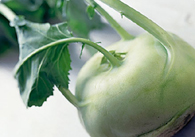 Kohlrabi shares its botanical name, brassica oleracea, with its close relative, broccoli. But kohl, meaning “cabbage”, and rabi, meaning “turnip”, better describes this delicate but unusual vegetable. Many botanists believe kohlrabi is actually a hybridization of these two vegetables. Kohlrabi resembles a root vegetable, but actually the edible globe is the modified swollen stem. The edible leaves jut from the globe portion of the kohlrabi like sparse hairs on a head, giving this vegetable it’s distinctive look. Purple and green varieties are often grown.
Kohlrabi shares its botanical name, brassica oleracea, with its close relative, broccoli. But kohl, meaning “cabbage”, and rabi, meaning “turnip”, better describes this delicate but unusual vegetable. Many botanists believe kohlrabi is actually a hybridization of these two vegetables. Kohlrabi resembles a root vegetable, but actually the edible globe is the modified swollen stem. The edible leaves jut from the globe portion of the kohlrabi like sparse hairs on a head, giving this vegetable it’s distinctive look. Purple and green varieties are often grown.
Kohlrabi also mimics its brassica relatives nutritionally. It offers generous amounts of vitamins A and C, and emphasizes the minerals potassium and calcium. It’s high in fiber and contains only 40 calories per cup.
from Asparagus to Zucchini: A Guide to Cooking Farm Fresh Seasonal Produce
